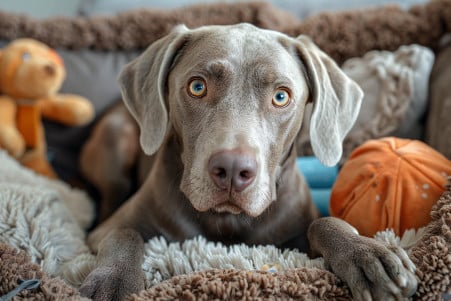Why Do Dogs Hump the Air? Unraveling the Curious Canine Behavior
30 March 2024 • Updated 29 March 2024

While watching a dog hump the air may be strange, it's usually nothing to worry about and can be caused by everything from excitement to hormone imbalances to medical problems. Humping in dogs is often related to sexual arousal, but it can also be a sign of anxiety, attention-seeking behavior, or a compulsive disorder. In some cases, dogs may hump due to urinary tract infections or skin issues, which can lead to them trying to relieve the discomfort of these problems.
To fully understand this strange dog behavior, we'll look at research from animal behavior, veterinary medicine, and evolutionary biology. By exploring the many ways that physiological, psychological, and social factors interact, we can uncover the many reasons that dogs hump and why it may not be as strange as it seems. This will, in turn, help dog owners understand their pets better and make sure they're getting the care and support they need.
Why do dogs hump the air?
Hormonal Influences and Sexual Behaviors
Mounting is often associated with hormonal changes and sexual arousal, especially in dogs that haven't been spayed or neutered. According to PetMD, female dogs that haven't been spayed may mount other dogs during their heat cycles or when they're around other female dogs in heat because of natural sexual behaviors and higher hormone levels.
However, even dogs that have been spayed or neutered may continue to mount due to the presence of hormones in their bodies or because the behavior has become a habit. The ASPCA also points out that while mounting and masturbation are normal behaviors, excessive humping may be a sign of an underlying medical issue, such as a urinary tract infection or skin allergy.
While mounting can be a sign of sexual motivation, it's also important to realize that neutered dogs may mount other dogs for reasons that have nothing to do with sex, including excitement, stress, and compulsive behaviors. A veterinarian can help you determine if there are any medical issues that are contributing to your dog's excessive mounting. By understanding the many causes of the behavior, dog owners can work to address and manage their pet's peculiar proclivity.
Arousal, Displacement, and Attention-Seeking
In addition to sexual reasons, humping can be a result of arousal, stress, or a need for attention. According to the Rover Q&A Community, humping the air is often the result of a "rush of emotions" and stress. This displacement behavior can help dogs work through their feelings and let off steam.
According to PawSafe, humping can also be a compulsive behavior in dogs, especially those who are anxious or not properly socialized. It can also be a way for dogs to get attention or ask for play. The Dutch blog points out that if humping is happening frequently, there may be an underlying issue, whereas if it's happening occasionally, it's more likely to be a result of boredom or a desire to interact.
Understanding and working to address the reasons behind humping, whether that means increasing exercise and mental stimulation or working on training to help dogs redirect their behavior, is important for helping to curb this strange dog behavior. By knowing the many reasons why dogs might hump, dog owners can make sure their pets are getting what they need and helping them find more appropriate ways to expend their energy and get attention.
How to Stop Humping: Training and Management Techniques
Stopping humping in dogs will likely require a combination of training and management techniques. As noted by The Wildest, one of the best ways to stop humping is to interrupt the behavior and then redirect the dog to a more appropriate behavior or toy. The site recommends using a leash or collar to gently lead the dog away if they don't respond to voice commands.
Positive reinforcement, including rewarding the dog when they stop humping on command, can also be very helpful. Vet Help Direct also notes that making sure your dog gets enough exercise and mental stimulation to prevent them from having too much pent-up energy can help reduce humping. If the behavior doesn't stop or gets worse, it may be time to work with a professional dog trainer or behaviorist who can help you figure out what's causing the behavior and how to address it.
As mentioned by Union Lake Veterinary Hospital, it's important to never use punishment to stop humping, as this can make the behavior worse. Instead, a combination of redirection, positive reinforcement, and environmental management can help you put a stop to this sometimes-embarrassing doggy behavior.
The Myth of Dominance
The most common myth about dog humping is that it is a display of dominance or an attempt to establish control. However, as the Whole Dog Journal points out, while humping can be a sign of dominance, especially when it comes to dog-on-dog humping, it is not the most common reason for the behavior.
Instead, humping is more often a sign of sexual arousal, stress, or a social behavior than a sign of dominance. As the Paws Abilities blog notes, dogs may hump because it is pleasurable, similar to how mammals masturbate, or because they are anxious and seeking attention, not because they are trying to control access to resources or establish a social hierarchy.
Recognizing the many different reasons for humping, from arousal and play to anxiety and stress relief, is important for helping pet parents deal with this sometimes awkward canine behavior. By understanding that dominance is less likely to be the cause, pet parents can take a more nuanced approach to managing and modifying the behavior.
Humping and Aggression: What's the Link?
While humping itself is not aggressive, it can lead to aggression in other dogs who don't want to be humped. As the Doglistener puts it, humping and mounting can cause "a violent and aggressive reaction from the victim." This is especially likely if the dog doing the humping has not been socialized properly during the critical period of canine development, which can result in a lack of understanding of what constitutes appropriate play and greetings.
Dogs that are aggressive and hump other dogs should be kept away from other dogs to prevent potential altercations. The PDSA notes that if your dog's humping is happening more and more frequently, it's important to address it because the behavior can lead to aggression in other dogs. Proper socialization and training that teaches dogs what constitutes appropriate play and greetings can help prevent humping from leading to aggression.
If humping is happening in conjunction with aggression or other problematic behaviors, it's important to get help from a professional dog trainer or behaviorist. They can help you figure out what's causing the behavior and create a plan to address it that's tailored to your dog, which will help ensure your dog and other dogs' safety and well-being.
Conclusion: Understanding and Addressing Canine Quirks
Humping is a common but often misunderstood behavior in dogs that can stem from a variety of hormonal, psychological, and medical factors. Understanding the diverse motivations behind this quirky conduct, from sexual arousal and dominance to stress and attention-seeking, is crucial for addressing it effectively.
By recognizing the underlying causes and providing appropriate outlets, training, and management strategies, pet owners can help curb unwanted humping behaviors and ensure the well-being of their canine companions. Seeking guidance from veterinarians or professional dog trainers can be particularly helpful for persistent or problematic cases.
Ultimately, approaching our dogs' unique behaviors with patience, empathy, and a willingness to learn can deepen the bond we share and enhance the overall care and enrichment of our beloved pets.


